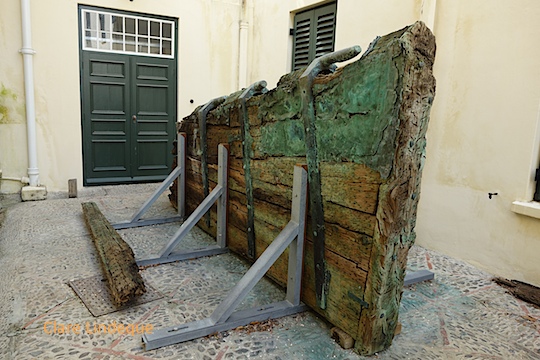I attended a talk about the Brunswick, which is wrecked off the end of Long Beach in Simon’s Town, at the Institute for Maritime Technology (IMT), in August. It was given by Jake Harding, who has just completed a thesis on the wreck for his Honours degree at the University of Cape Town. Considering that all I know about the Brunswick (even with reference to Shipwrecks and Salvage in South Africa) can be summed up in two sentences, it was extremely interesting to hear from someone who has researched the ship, and examined the wreck for further information.
The ship
The Brunswick was an East Indiaman, a merchant ship that transported goods between Britain and the East Indies. She was captured by the French vessel Marengo in 1805, and brought to Simon’s Town as a prize of war. She was captured on her sixth voyage and was in quite poor shape. Five or six voyages was considered a good lifespan for an East Indiaman. They travelled very long distances on each voyage and were away from their home ports for over a year at a time, sometimes much longer. During the time she was at anchor in Simon’s Bay, strong winds caused her anchor cables to part, and she ran aground. She was carrying a cargo of sandalwood and cotton, which was sold along with the wreck in an auction. Most of it was salvaged, although archaeologists have spotted the odd piece of sandalwood on the wreck site.
She had 30 guns, which is apparently quite a small number – warships of the time would have had hundreds of guns. At the time when the Brunswick was constructed (late 18th century), iron was used instead of hardwood for the braces or “knees” that held the hull of the ship out in its characteristic shape. She was about 40 metres long and 13 metres wide with three decks. Her hull was sheathed in copper, and the drift bolts holding the parts of the ship together are copper and iron.
The wreck
The wreck was officially discovered and identified as the Brunswick in 1993, although her rudder was found and salvaged in 1967. It can be seen in the courtyard of the Slave Lodge in central Cape Town, formerly the South African Cultural History Museum. It used to be covered with copper sheets, but those were mostly stripped off. It’s huge – over 4 metres long, but with all the original fittings it was likely over 5 metres in length.

It’s clear when you dive the site that there’s quite a lot of wreck hidden under the sand, and even in the few times we’ve dived her we’ve been able to see how the sand shifts and covers and uncovers various parts of the ship. The Simon’s Town harbour wall has led to a lot of sediment build up in the area. When the wreck was surveyed in 1994-1995 for Project Sandalwood, a survey done by IMT and the South African Cultural History Museum, they recorded pieces three metres high sticking out of the sand. There’s nothing like that today. Longshore currents also cause periodic sediment build up and removal, and the cryptic little fish called steentjies annually uncover huge areas of the wreck during their mating displays.
According to Jake, the keelson (like a keel strip), part of the copper strap attaching the rudder to the boat, and a large number of iron knees (we have only seen a couple), and one or two pieces of sandalwood are still on the wreck site. We will be looking carefully for these elements next time we dive there.







